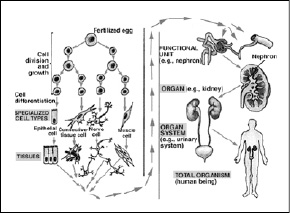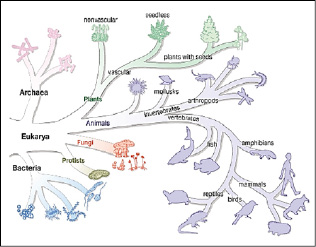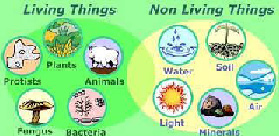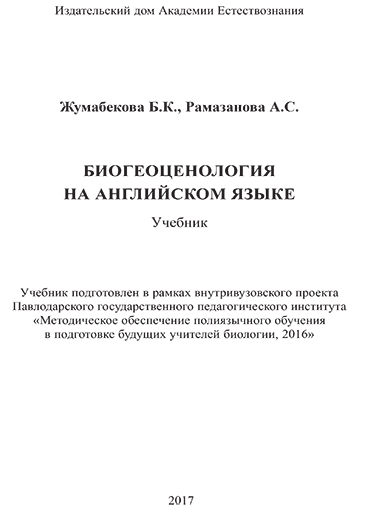
Научная электронная библиотека
Монографии, изданные в издательстве Российской Академии Естествознания
Chapter 2. LIFE, LIVING THINGS AND «LIVING MATTER»
ЖИЗНЬ, ЖИВОЕ И «ЖИВОЕ ВЕЩЕСТВО»
|
Essential targets: By the end of this chapter you should be able to: recognize and describe the characteristics of living organisms; discuss about the definition of «living matter»; distinguish the living things and non-living one. |
Read the given text and make illustration for each characteristics of Life / Берілген мәтінді оқып шығыңдар және тіршіліктің әрбір сипаттамасына сурет салыңдар / Прочитайте данный текст и сделайте иллюстрации для каждой характеристики жизни.
Life is the condition that distinguishes organisms from inorganic objects and dead organisms, being manifested by growth through metabolism, reproduction, and the power of adaptation to environment through changes originating internally [1].
The 7 Characteristics of Life:
1. Living Things are Composed of Cells:
• Single-cell organisms have everything they need to be self-sufficient.
• In multicellular organisms, specialization increases until some cells do only certain things.
2. Living Things Have Different Levels of Organization:
• Both molecular and cellular organization (Fig. 1).
• Living things must be able to organize simple substances into complex ones.
• Living things organize cells at several levels:
• Tissue – a group of cells that perform a common function.
• Organ – a group of tissues that perform a common function.
• Organ system – a group of organs that perform a common function.
• Organism – any complete living thing.

Figure 1. Levels of Cellular Organization [2]
3. Living Things Use Energy:
• Living things take in energy and use it for maintenance and growth.
4. Living Things Respond To Their Environment:
• Living things will make changes in response to a stimulus in their environment.
• A behavior is a complex set of responses.
5. Living Things Grow:
• Cell division – the orderly formation of new cells.
• Cell enlargement – the increase in size of a cell. Cells grow to a certain size and then divide.
• An organism gets larger as the number of its cells increases.
6. Living Things Reproduce:
• Reproduction is not essential for the survival of individual organisms, but must occur for a species to survive.
• All living things reproduce in one of the following ways:
• Asexual reproduction – Producing offspring without the use of gametes.
• Sexual reproduction – Producing offspring by the joining of sex cells.
7. Living Things Adapt To Their Environment:
• Adaptations are traits giving an organism an advantage in a certain environment.
• Variation of individuals is important for a healthy species [2].
Living matter is the aggregate of living bodies of biosphere organisms, which are expressed numerically by elementary chemical composition, mass, and energy. The term “living matter” was introduced by V. I. Vernadsky. Materially and energetically the biosphere is connected with living matter through the biogenic migration of atoms that occurs with breathing, eating, growth, and the multiplication of organisms. Living matter is exemplified by autotrophic organisms (green plants and autotrophic microorganisms), heterotrophic organisms (plants without chlorophyll, all animals, and human beings), and mixotrophic organisms, which live on ready-made organic compounds, although they are also able to synthesize them (Fig. 2) [3].

Figure 2. Living things [4]
Glossary of essential terms / Негізгі терминдер глоссарийі / Глоссарий основных терминов
|
№ |
English term |
Kazakh equivalent |
Russian equivalent |
|
1 |
aggregate |
жиынтық |
совокупность |
|
2 |
behavior |
мінез-құлық |
поведение |
|
3 |
breathing |
тыныс алу |
дыхание |
|
4 |
division |
бөлу |
деление |
|
5 |
increase |
арттыру |
увеличение |
|
6 |
joining |
қосылу |
присоединение |
|
7 |
orderly |
реттелген |
упорядоченный |
|
8 |
reproduction |
көбею |
размножение |
|
9 |
stimulus |
тітіркендіргіш |
раздражитель |
|
10 |
survival |
тірі қалу |
выживание |
|
11 |
tissue |
ұлпа |
ткань |
|
12 |
to perform |
орындау |
выполнять |
|
13 |
to respond |
әрекеттесу |
реагировать |
|
Questions: Do all living things have all of the characteristics of life? If your answer is no, give an example. Name some non-living thing that uses energy. Name some non-living thing that grows. |
|
Key phrases and sentences / Түйінді сөздер мен сөйлемдер / Ключевые фразы и предложения 1. Live is characterized by following features: … / Тірі заттардың белгілері: .../ Живые вещества характеризуются следующими признаками: … 2. Living matter is the aggregate of … / Тірі зат дегеніміз - … жиынтығы / Живое вещество – это совокупность … 3. The term «…» was introduced by … in …/ «…» термині ... ж. ...ұсынылды/ Термин «…» был введен … в … году. |
I. Match these words with their definitions / Терминдерді олардың анықтамаларымен сәйкестендіріңдер / Сопоставьте термины с их определениями.
|
1. |
Decomposers |
A. |
organisms that obtain their energy from the chemical breakdown of dead organisms as well as from animal and plant waste products |
|
2. |
Ecology |
B. |
the biological conversion of light energy from the Sun to chemical energy in plants |
|
3. |
Photosynthesis |
C. |
the changes that particular elements undergo as they pass back and forth through the various earth systems (e.g., the biosphere) and particularly between living and non-living matter |
|
4. |
Biogeochemical cycles |
D. |
study of organisms and their interactions with the environment |
|
5. |
Biosphere |
E. |
the pattern of weather conditions in a particular region over an extended period |
|
6. |
Climate |
F. |
all living things in an environment |
|
7. |
Hydrocarbon |
G. |
any organic chemical compound whose molecules are made up of nothing but carbon and hydrogen atoms |
|
8. |
Biotic factors |
H. |
a combination of all living things on Earth—plants, animals, birds, marine life, insects, viruses, single-cell organisms, and so on—as well as all formerly living things that have not yet decomposed |
|
9. |
Abiotic factors |
I. |
all abiotic and biotic factors in a given area |
|
10. |
Ecosystem |
J. |
physical and chemical conditions in an environment |
II. Find English and Kazakh equivalents to the following word combinations / Келесі сөз тіркестерінің ағылшын және қазақша баламаларын табыңдар / Найдите английский и казахский эквиваленты для следующих словосочетаний.
|
№ |
Russian term |
English equivalent |
Kazakh equivalent |
|
1. |
биологический компонент |
||
|
2. |
высокий уровень организации |
||
|
3. |
геолог |
||
|
4. |
метод элементарного химического состава |
||
|
5. |
основная концепция |
||
|
6. |
планета |
||
|
7. |
популяция |
||
|
8. |
ресурс |
||
|
9. |
совокупность живых организмов |
||
|
10. |
экологическое использование |
III. Look at the picture. Describe and distinguish the living things and non-living things. How do they interact? (Fig. 3) / Суретті қарап шығыңдар. Сипаттаңдар, тірі және өліні анықтаңдар. Олар қалай өзара әрекеттеседі? / Рассмотрите картинку. Охарактеризуйте и выделите живое и неживое. Как они взаимодействуют?

Figure 3. Living and non-living things [5]
IV. Make a crossword puzzle on the chapter 3 / 3-тарауға сөзжұмбақ құрастырыңдар / Составьте кроссворд к 3 главе.
|
SUMMARY Living matter is the aggregate of living bodies of biosphere organisms, which are expressed numerically by elementary chemical composition, mass, and energy. The term “living matter” was introduced by V. I. Vernadsky. According to V. I. Vernadsky the biosphere serves as the highest level of biological organization, which begins with parts of cells and proceed to populations, species, ecoregions, biomes and finally, the biosphere. The Noosphere is the sphere of human thought. In the theory of Vernadsky, the Noosphere is the third in a succession of phases of development of the Earth, after the geosphere (inanimate matter) and the biosphere (biological life). |
 Topics for essay:
Topics for essay:
1. Planetary role of living matter.
2. The Noosphere concept by V. I. Vernadsky: for and against.
3. Biosphere and its sustainability.
4. Geological shell and Geosphere of Earth according to V. I. Vernadsky.
5. The biosphere and civilization.
6. Technosphere as part of the biosphere.
7. Living matter and the levels of its organization.
8. Living matter and its role in the development of the biosphere.
9. The Noosphere and the environmental crisis.
10. The biosphere and its evolution.
 References:
References:
1. Dictionary // http://www.dictionary.com/browse/life
2. The 7 Characteristics of Life // http://infohost.nmt.edu/~klathrop/ 7characterisitcs_of_life.htm
3. The free dictionary // http://encyclopedia2.thefreedictionary.com/Living+ Matter.
4. Britannica Kids // http://kids.britannica.com/elementary/art-160418/Scientists-divide-all-living-things-into-groups-based-on-features\
5. Living Things and Non-living Things // http://jayakumar07.blogspot.com/
